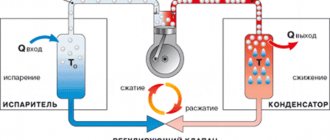In the Soviet Union, gas-powered trucks took over the lion's share of home front work during the war.
Today, wood-burning cars, that is, those equipped with a gas generator engine, seem like an anachronism. But perhaps in the future they will be in demand again due to the gradual depletion of hydrocarbon reserves. In other words, for the same reason why “gasgens” in the mid-twentieth century became a real salvation for warring countries. Almost all the gasoline during the war went to tanks, airplanes and military trucks, and in the rear, cars were useful that could be “refueled” with anything - from coal briquettes to pine cones and from pine logs to straw.
Gas generator diagram and operating principle
Carbon is the basis of all biomass on our planet, including wood and various coals, into which compressed plants have turned over millions of years. In heating boilers and internal combustion engines (ICE), we burn hydrocarbons extracted from the depths of the earth: methane, propane and gasoline. They become more expensive every year, forcing home craftsmen to look for new ways using old inventions. One of them is cars with wood-burning gas generators, which appeared at the beginning of the last century.
In the first half of the 20th century, cars and trucks were equipped with wood-burning units.
The essence of the idea is to obtain from wood, through pyrolysis, a gaseous combustible mixture consisting of several carbon-based compounds:
- carbon monoxide (CO);
- free hydrogen (H2);
- well-known methane (CH4);
- other hydrocarbon compounds (general formula - CnHm).
Note. The main flammable component of the mixture is carbon monoxide CO; the proportion of other substances from the list is small. It also contains other gases called ballast - nitrogen, carbon dioxide (CO2) and water vapor. Data on the percentage of substances in the final product and its calorific value are presented in the table:
To release gaseous fuel, a wood-burning pyrolysis gas generator (otherwise known as gasgen) is used, the device of which is shown in the diagram. This is a closed container with grates, filled with solid fuel through the upper hopper, instead of a chimney - a gas mixture outlet pipe. The operating principle of the gasgen is as follows:
- Ignition and combustion of an array of firewood occurs from below, above the grate. A limited amount of air is blown into the chamber through tuyeres (35% of the volume required for complete combustion).
- A large amount of heat is released in the combustion zone and, as a result of the reaction of oxygen with carbon, carbon dioxide CO2 is formed. The content of carbon monoxide and other flammable substances here is low.
- In the reduction (gasification) zone, under the influence of high temperature, carbon dioxide is saturated with carbon from wood and turns into a flammable compound - CO. Here the decomposition of water vapor and the formation of free hydrogen occurs.
- Hot gases passing through the upper layers of fuel dry out the wood and cause it to turn into charcoal (dry distillation), which releases more carbon.
- The gas mixture leaves the gas generator body and is sent for subsequent cleaning to be supplied to the internal combustion engine or boiler.
Functional diagram of a direct process gas generator
For reference. The reduction of carbon dioxide (conversion into CO) occurs with the absorption of heat released during the combustion process. By the way, there are no clear boundaries between the zones and they are shown conditionally in the drawing.
The principle of horizontal gasification - a mixture of combustible gases exits through the side pipe of the generator.
For clarity, we have described the generation of fuel through a direct gasification process, when the fuel mass moves towards the air flow. There are other methods - the reverse process (air is blown from top to bottom) and the horizontal method, shown above in the gas generator diagram. If you want to understand the theoretical aspects in detail, we suggest watching the following video:
The forest is being cut down - the chips are flying
The idea of using gas obtained from the combustion of solid fuel to propel various vehicles was invented and first implemented in France. Some researchers point to 1801 as a starting point, when the inventor of lighting gas, Philippe Le Bon, received a patent for a gas engine. But that was just a theory. Already in the second half of the 19th century, the Belgian Etienne Lenoir and the German Nicholas Otto presented their working samples of gas engines. However, the first full-fledged gas-generating car, capable of running on wood and charcoal, was introduced by Thomas Parker in 1901.
The following years were marked by a number of practical experiments, the greatest interest in which was demonstrated by France, which at that time was experiencing a significant shortage of energy resources. In the mid-2000s, the first gas-generating tractors and trucks underwent a series of tests in Morocco, and in 1914, a Berliet regular bus was launched in France, plying the Paris-Rouen route. At the same time, a number of problems with existing gas generator engines were identified. In addition to the relatively low efficiency, they turned out to be quite sensitive to the quality of solid fuel. So, in order to avoid resin deposition and equipment damage, an additional installation of a gas purifier was required, which could not have a positive effect on the weight of the already large structure. This could have been the end of the history of gas generator engines, but another story intervened. The First World War began, which forced the warring parties to reconsider their economic priorities.
Previous photo
A gas-generating vehicle places increased demands on the driver. He not only has to monitor the proper operation of the equipment, but also prepares the material. In addition, if firewood is used, the driver must make sure that the logs have not become damp during the rain and are also of the appropriate size for loading into the hopper. Considering these and other operating difficulties, many perceived gas-generating vehicles as a burden that was easier and more reliable to get rid of.
Next photo
1 / 2
A gas-generating vehicle places increased demands on the driver. He not only has to monitor the proper operation of the equipment, but also prepares the material. In addition, if firewood is used, the driver must make sure that the logs have not become damp during the rain and are also of the appropriate size for loading into the hopper. Considering these and other operating difficulties, many perceived gas-generating vehicles as a burden that was easier and more reliable to get rid of.
Installation design
To successfully operate a car using wood or burn the resulting fuel in a boiler, one gas generator is not enough. The fact is that in addition to ballast gases, homemade fuel contains volatile impurities and resins, in other words, smoke and soot. Neither the car engine nor the boiler burner device is designed for such fuel and will quickly fail. Therefore, a filtration system was invented, which is part of the gas generator unit and includes 3 additional units:
- coarse filter – cyclone;
- radiator - cooler;
- fine filter.
The order of placement of these elements is shown in the technological diagram:
A cyclone for a gas generator is a vertical cylinder with two pipes and a cone at the end, as shown in the drawing. The contaminated gas mixture, getting inside it, moves in a circle at high speed, due to which large and medium-sized ash particles are thrown onto the walls by centrifugal force and removed through a hole in the cone.
Scheme of operation of a cyclone that purifies power gas from impurities
The higher the temperature of the gas, the lower its density. This means that the fuel at the outlet of the gas engine cannot be used in an internal combustion engine without pre-cooling, otherwise it simply will not ignite in the cylinders. Therefore, in industrial gas generating plants, immediately after the cyclone, an air or water heat exchanger is installed, and then a compressor that pumps the cooled gas mixture into the distribution tank.
At the end of the technological chain there is a fine filter that removes small particles of soot and ash from the resulting fuel. An example of such a unit is the so-called scrubber, in which gases are purified by blowing through water. Now that we have understood the technology for producing fuel, we can make our own inexpensive installation that can ensure the operation of an internal combustion engine using wood.
Homemade gasgen made by foreign colleagues
Alternative to gasoline
In the early twenties of the last century, many countries, exhausted by the war, began mass production of gas generators. Among them were Austria, Sweden, Germany and, of course, France, which by this time had achieved considerable success, being one of the first to implement the system developed by the inventor Georg Imbert. The principle of its operation was partially substituted pyrolysis, in which coal and wood are burned in a boiler, and not in cylinders, as was previously carried out. At the same time, various equipment layout options were assumed both in the vertical and horizontal planes, which somewhat expanded the possibilities of application. Despite the presence of many other systems, such as, for example, gas generators developed by Panhard, Barbier, Macdonald, Krupp, Berliet and Goen, the device invented by Imbert was considered one of the most popular until the end of the forties.
On the eve of World War II, about tens of thousands of gas-generating cars, built on the basis of production models, roamed the roads of Europe. And that was just the beginning. After the continent was engulfed in hostilities, in the rear, firewood became perhaps the only available alternative to gasoline, which was sent straight to the front.
Making gasgen for a car
Before making a working gas generator for a car, we suggest that you familiarize yourself with some recommendations:
- Organizing the supply of power gas in a modern car with an injector is not an easy task. You will have to change the controller settings (firmware), otherwise the wood fuel motor will not work. You need a car with an old fuel supply system - a carburetor.
- The greater the power and displacement of the engine, the higher the performance of the gas generator. Accordingly, it will grow in size.
- To fit the installation into the trunk of a passenger car, you will need to cut out part of the bottom. If you do not want to touch the body, then immediately plan to install a wood-burning generator with filters and a cooler on the trailer.
- To make a gasification chamber where the temperature exceeds 1000 °C, use low-carbon thick steel (4-5 mm).
- To reduce the resin content in the gas mixture, make a chamber with a neck, as shown in the drawing.
Important point. You should not increase the diameter of the gasification chamber (in the drawing it is 340 mm) in order to achieve greater productivity. The increase will be negligible, and the quality of wood processing will deteriorate. But it is not necessary to maintain a height of 183 cm, unless you place the unit on a trailer or on a truck frame. The fuel hopper and ash pan can be shortened.
To assemble the inside of a car gas generator (bunker), an old propane cylinder, a receiver from a KamAZ truck, or a thick-walled pipe will do. Considering that the diameter of the steel vessel is 300 mm, the remaining dimensions must be proportionally reduced. The exception is the gasification chamber, its minimum diameter is 140 mm. The casing and cover of the generator will use metal 1.5 mm thick. The latter is sealed with graphite-asbestos cord.
Options for fuel mixture coolers from a car radiator and radiator
Related units - filters and coolers - are made like this:
- Weld a cyclone from a used fire extinguisher or a piece of pipe with a diameter of 10 cm, as shown in the drawing. Attach the inlet pipe to the side, the outlet pipe to the top.
- It is better to make a power gas cooler from steel pipes in the form of a coil. There are other options: using old convectors, radiators and radiators.
- Make a fine filter from any cylindrical container (for example, a barrel) filled with basalt fiber.
You can get more detailed information about assembling a gas generator yourself by watching the video:
To ignite and start the gas engine, you will need a snail-shaped fan installed in the engine compartment (a household vacuum cleaner will also do for testing). The requirement for it is simple: parts in contact with the gas mixture must be metal. The fuel line leading to the carburetor is laid under the bottom of the car and is made of steel pipe.
For reference. If you use charcoal instead of firewood, then there will be significantly fewer impurities at the gas generator output, which is good for the engine. Such fuel is burned from wood using a simple technology - in a closed barrel or pit.
The charcoal bunker fits into the trunk of a Zhiguli.
Technological process
The resulting gas alone is unsuitable for internal combustion engines, so it is necessary to follow a certain process, which is divided into stages:
- Firewood should not be burned, but decomposed thermally due to the low oxygen supply.
- The next stage is determined by the removal of suspended particles using a filter.
- The mixture is then cooled using an air or liquid heat exchanger.
- After this, the mixture is purified using fine cleaning.
- At the last stage, the fuel enters the mixer and then enters the engine.
Connecting and starting the internal combustion engine
Since the calorific value of fuel generated from firewood is much lower than that of gasoline, the air/fuel ratio must be changed for normal engine operation. To do this, you will have to make a mixer and place it on the intake tract. The simplest type of mixer is an air damper controlled by a draft from the passenger compartment.
Starting a cold engine on wood is quite a task. Therefore, you should not completely abandon gasoline, but supply it only during startup, and then switch to fuel produced by gas. To implement switching to different types of fuel, make a mixer according to the scheme proposed in the book by I. S. Mezin “Transport gas generators”:
Note. In this book you will find a lot of useful information regarding the production of gaseous fuels from various types of wood and coal.
Now about the features of starting and operating internal combustion engines on wood and coal:
- the size of firewood loaded into the bunker should not exceed 6 cm;
- raw wood cannot be used, since all the heat generated will be used to evaporate water and the pyrolysis process will be extremely sluggish;
- ignition is carried out through a special hole with a check valve with the fan turned on no later than 20 minutes before the trip;
- engine power is reduced by about 50% compared to driving on gasoline;
- It follows from the previous paragraph that the service life of the engine on homemade fuel is also reduced.
It is noteworthy that after short-term parking, the car starts easily from the gas engine, without switching to gasoline. After a long period of inactivity, it will take 5-10 minutes to re-ignite the unit. How to start a car engine from a homemade wood-burning gas generator, see the following video:
What does pyrolysis gas consist of?
The type of wood does not affect the composition of the mixture during pyrolysis. Accordingly, birch, pine and spruce emit almost the same amount of all of the above gases. After pyrolysis 1 cu. m of wood you can get about 90 m3 of non-condensable gas.
The useful heat from the combustion of 1 m3 of non-condensable gas, kJ/m3, is calculated by the formula.
For example, let’s take a birch tree and calculate the calorie content of gas:
Qnr=127.5*28.4%+108.1*3.0%+358.8*18.2+604.4*1.4=11,321.62 kJ/m3= 11.3 MJ/m3
Then divide the resulting number by 4.187. Thus, Qnr will be equal to 2704 kcal/m3. For comparison, the calorific value of natural gas is 8000 kcal/m3.
What is the best air heating equipment?
Buyers have many questions regarding long-burning stoves: how to choose the best model or design, where could there be a catch? All models of this type of equipment differ in their advantages and disadvantages. The choice must be made based on the requirements of a particular room.
Butakov stove, design.
The design of Butakov's heating device. This is a long-burning convection oven, which has the following structure:
- steel or cast iron body;
- combustion chamber;
- ash pan;
- convection pipes that run throughout the chamber;
- door with convector;
- chimney;
- adjusting slide.
Compared to its Canadian counterpart, the firebox of the Butakov stove is not divided into two chambers. However, this fact does not affect the performance of the device. Thus, the efficiency of Butakov’s heating equipment reaches 80-85%. The operating principle of the Butakov furnace, like all air heating devices, is based on two phenomena: pyrolysis and convection.
Pyrolysis occurs directly in the combustion chamber, where firewood is placed. Under the influence of high temperatures and in an environment of insufficient oxygen, organic matter decomposes into gas and water. The latter comes out with combustion products. Carbon monoxide and a mixture of other wood derivatives in the upper part of the chamber ignite, since secondary, heated air is supplied there. The temperature of the upper part of the firebox of the Butakov stove is much higher compared to the lower part, and therefore is often used for cooking.
Air convection passes through the pipes. They are located in the upper part of the firebox at a certain distance from each other and at the desired angle. This design of the device ensures the fastest passage of cold air from the bottom of the room and its maximum heating. Air convection also occurs through the door of the device. There you can see the corresponding holes.
Butakov's long-burning metal stove has a significant advantage compared to other models of similar devices. Its chimney pipe is located in such a way that condensate does not accumulate in the container, but flows down the walls of the pipe, entering the combustion chamber, where it burns.
The operating principle of the Buleryan long-burning furnace.
What is a Buleryan stove? If we compare the Butakov and Buleryan long-burning stoves, the second has two chambers in the combustion section, which improves its efficiency. Thus, the efficiency of Buleryan heating equipment reaches 85-90%. In addition, today there is a Buleryan-Aqua stove on sale, which is suitable for servicing a water heating system.
The device has the following structure:
- oval body made of steel or cast iron;
- collectors;
- injectors;
- upper combustion chamber;
- lower combustion chamber;
- chimney with damper;
- door with gate;
- ash pit.
These are the most efficient long-burning stoves, since their original design allows air to be pumped inside the convector with injectors without the help of an electric fan. Natural air circulation occurs due to a noticeable temperature difference at the inlet and outlet of the tubes. It is about 120°C.
Trimming the Buleryan-Aqua stove with a water jacket.
Air ducts can be connected to the furnace convectors. This makes it possible to heat adjacent rooms. In conditions of elevated air temperature that circulates through pipes, it is recommended to use aluminum air ducts. However, no one has canceled heat loss, and therefore the consumer, wanting to increase the efficiency of heat transfer, is obliged to insulate the ventilation wiring.
Another feature that characterizes the long-burning cast iron heating stove Buleryan-Aqua is the ability to connect a water heating circuit to it. The stove is installed in a heating system of both open and closed types. To do this, the pipes are connected to the convectors of the heating equipment. And now it is not air, but water from the heating circuit that circulates through the pipes inside the firebox. This type of wiring has one significant drawback - cold water cools the combustion chamber. As a result, the efficiency of the furnace also decreases, as a result of which the amount of energy used increases.
The disadvantage of the device is the accumulation of condensate in a special container. Also, when using an energy carrier with a high percentage of moisture, oily deposits form on the inner surface of the chimney. They harden over time, making cleaning more difficult.
In addition to the above options, experts advise building long-burning stone stoves for a dacha or country house. How it works and its operating principle are described in the video:
How to build it yourself
Gas generator diagram. (Click to enlarge)
Making a gas wood generator with your own hands is not that difficult.
First, you need to understand the principle of its operation, structure, circuit, then you should draw drawings of the future energy source and begin selecting the necessary materials.
Each gas generator must include:
- supporting structure;
- a bunker that will contain wood or other fuel;
- chamber where the combustion process occurs;
- tuyeres for supplying blast;
- air distribution boxes;
- gas pipeline;
- a cyclone for filtering the exhaust gas from dust and small particles and various transverse grids used for cleaning;
- cooler;
- a cylinder for collecting gas and its further distribution;
- grate to support coal.
Gazgen can also be installed on car and tractor engines that require a lot of fuel.
Home mini-heat generators are increasingly found in homes due to the simplicity of the device and the low cost of installation and maintenance, because wood is a very affordable type of fuel.
It is also possible to install small power plants along with steam generators that will rotate a turbine to generate electricity. The process of making homemade units is not very labor intensive.











